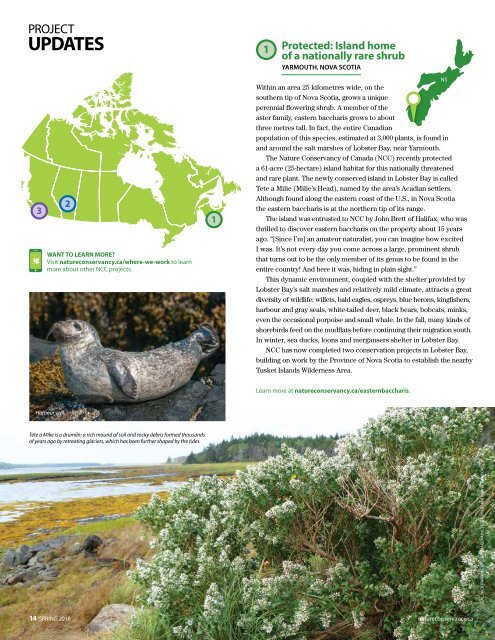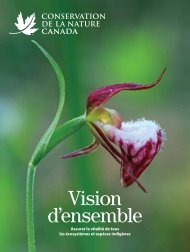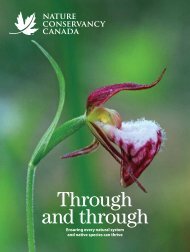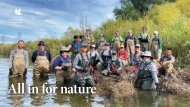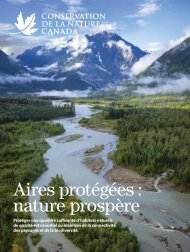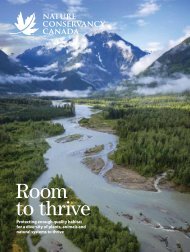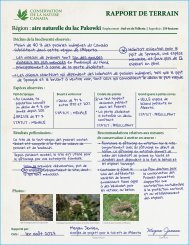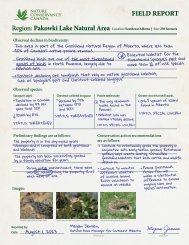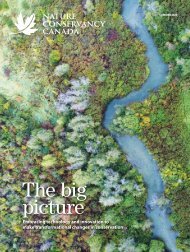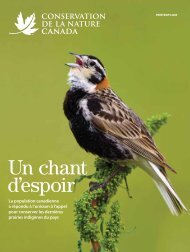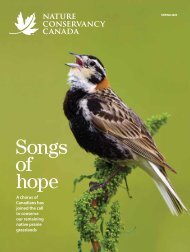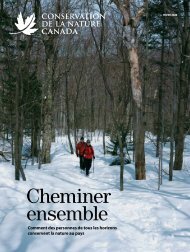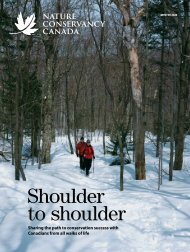Spring 2018 NCC Magazine
You also want an ePaper? Increase the reach of your titles
YUMPU automatically turns print PDFs into web optimized ePapers that Google loves.
PROJECT<br />
UPDATES<br />
3<br />
2<br />
WANT TO LEARN MORE?<br />
Visit natureconservancy.ca/where-we-work to learn<br />
more about other <strong>NCC</strong> projects.<br />
1<br />
1<br />
Protected: Island home<br />
of a nationally rare shrub<br />
YARMOUTH, NOVA SCOTIA<br />
BC NS<br />
Within an area 25 kilometres wide, on the<br />
southern tip of Nova Scotia, grows a unique<br />
perennial flowering shrub. A member of the<br />
aster family, eastern baccharis grows to about<br />
three metres tall. In fact, the entire Canadian<br />
population of this species, estimated at 3,000 plants, is found in<br />
and around the salt marshes of Lobster Bay, near Yarmouth.<br />
The Nature Conservancy of Canada (<strong>NCC</strong>) recently protected<br />
a 61-acre (25-hectare) island habitat for this nationally threatened<br />
and rare plant. The newly conserved island in Lobster Bay is called<br />
Tete a Milie (Milie’s Head), named by the area’s Acadian settlers.<br />
Although found along the eastern coast of the U.S., in Nova Scotia<br />
the eastern baccharis is at the northern tip of its range.<br />
The island was entrusted to <strong>NCC</strong> by John Brett of Halifax, who was<br />
thrilled to discover eastern baccharis on the property about 15 years<br />
ago. “[Since I’m] an amateur naturalist, you can imagine how excited<br />
I was. It’s not every day you come across a large, prominent shrub<br />
that turns out to be the only member of its genus to be found in the<br />
entire country! And here it was, hiding in plain sight.”<br />
This dynamic environment, coupled with the shelter provided by<br />
Lobster Bay’s salt marshes and relatively mild climate, attracts a great<br />
diversity of wildlife: willets, bald eagles, ospreys, blue herons, kingfishers,<br />
harbour and gray seals, white-tailed deer, black bears, bobcats, minks,<br />
even the occasional porpoise and small whale. In the fall, many kinds of<br />
shorebirds feed on the mudflats before continuing their migration south.<br />
In winter, sea ducks, loons and mergansers shelter in Lobster Bay.<br />
<strong>NCC</strong> has now completed two conservation projects in Lobster Bay,<br />
building on work by the Province of Nova Scotia to establish the nearby<br />
Tusket Islands Wilderness Area.<br />
Learn more at natureconservancy.ca/easternbaccharis.<br />
Harbour seal<br />
Tete a Milie is a drumlin: a rich mound of soil and rocky debris formed thousands<br />
of years ago by retreating glaciers, which has been further shaped by the tides.<br />
SEAL: NICK HAWKINS. EASTERN BACCHARIS, TETE A MILIE: ANTHONY CRAWFORD.<br />
14 SPRING <strong>2018</strong> natureconservancy.ca


